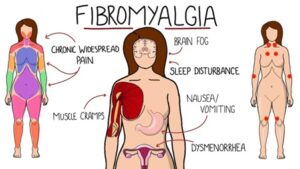Fibromyalgia is classified as a painful musculoskeletal disorder characterised from altered brain and spinal cord processing of pain pathways. Overtime the brain’s pain receptors become sensitised from repeated (and potentially inaccurate) pain receptors. Repeated nerve stimulation causes changes in the brain and spinal cord resulting in an overreaction to painful and nonpainful signals.
Diagnosis of fibromyalgia is administered alongside a health professional and includes an evaluation of pain and other symptoms through a Widespread Pain Index and Symptom Severity Scale questionnaire. Individuals with fibromyalgia can have a range of symptoms and presentation depending on the severity of their condition.
Symptoms
- Pain (chronic, sharp, sudden or dull) and stiffness across multiple sites
- Fatigue and tiredness
- Difficulty falling asleep or sleep disturbances
- Depression and anxiety
- Difficulty with thinking, memory, and concentration
- Headaches including migraines
- Gastrointestinal upset or IBS (constipation, nausea, passing excessive gas)
- Pins and needles or sensitivity to pain
ACSM Exercise Guidelines for Individuals with Fibromyalgia
| Type | Frequency | Intensity | Time |
| Aerobic Low impact rhythmic, continuous activity e.g. aquatic, walking, dance, cycling | Start with 1-2 /7. Build up to 2-3 /7. | Begin very light to light. Build to light to moderate. | Start with 5-10 mins. Gradually build up to 30-60mins accumulated daily. |
| Strength Free weights, bands, machines, body weight. | 2-3 /7 with minimum 2 days rest in between | Start fairly light to somewhat hard. Build to somewhat hard to difficult. | Start with 4-5 reps, build to 8-12 reps of each major muscle group. Gradually build 2-4 sets. |
| Endurance Free weights, bands, machines, body weight. | 2-3 /7 with minimum 2 days rest in between | Very light to fairly light. | 15-20 reps, build to 2 sets. |
| Flexibility Static and dynamic stretches (passive and/or active) for all major muscle groups. | 2-3/7 | Stretch within limits of pain to the point of tightness or slight discomfort. | Hold stretch for 10-30 secs. |
Benefits to Exercise for Individuals with Fibromyalgia
Improved…
- Quality of life including, general well-being, lower rates of depression and fewer work absences.
- Improved self-perception and concept including improved understanding for individual’s capacity.
- Symptom management including fatigue, pain levels, pins and needles and tender spots.
- Sleep management including duration and quality.
- Pain reduction and management when the individual is completing a personalised program.
- Ability to maintain healthy body weight, strengthen bones and increase heart health.




